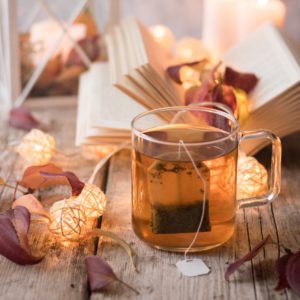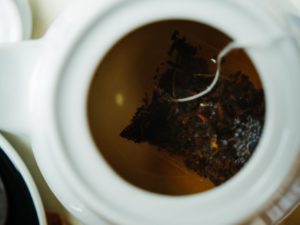 Did you know that commercial tea bags are made with a plastic component so you cannot put them in compost bin anymore? They simply do not break down and contribute adding microplastics and nano-plastics to our soil and waterways and worse still the possible health effects of ingesting these particles are currently unknown.
Did you know that commercial tea bags are made with a plastic component so you cannot put them in compost bin anymore? They simply do not break down and contribute adding microplastics and nano-plastics to our soil and waterways and worse still the possible health effects of ingesting these particles are currently unknown.
Tea bags are made from either PLA (or cellulose with a small amount of “polymer” (plastic) for strength) or PP (Polypropylene - Recyclable Plastic).
The researchers over at ACS' Environmental Science & Technology found that a single plastic teabag at brewing temperature released about 11.6 billion microplastic and 3.1 billion nano-plastic particles into the water – which you then ingest. That soothing herbal tea you love to drink comes with a dose of plastic – kind of not the healthy outcome you might have been looking for. Read more about this study HERE.
Make a conscious decision to challenge companies who make tea to with plastics in their tea bags - in the old day’s tea bags were not made with plastic and they were 100% compostable.
For a tea bag to be safely added to your compost heap or worm farm, the following requirements must all be met:
- The paper breaks down into water, carbon dioxide or methane, and biomass (organic matter).
- The plastic seal fully disintegrates.
- There are no toxic residues.
- The resulting matter can support plant growth.
It’s easy to swap to loose leaf tea if you have a tea basket or tea pot with a strainer. Tea making is a beautiful meditative process and by using loose leaf tea you will not only experience a better flavour you will help prevent plastic from entering our land and waterways.
The best way to make tea is either to place it loose in a teapot or to use a tea strainer. The more the loose tea can move around the better your infusion will be.
This excerpt is taken straight from the NZ Consumer website:
What manufacturers use to seal their tea bags
Many tea bags are sealed with a thermoplastic such as polypropylene (PP, the recyclable plastic coded “5”) or plant-based polylactic acid (PLA, “7”). We asked 17 distributors what they used to seal their tea bags. Here are their edited responses:
Many tea bags are sealed with a thermoplastic such as polypropylene (PP, the recyclable plastic coded “5”) or plant-based polylactic acid (PLA, “7”). We asked 17 distributors what they used to seal their tea bags. Here are their edited responses:
Bell Original - Polypropylene. Tea bags are made from cellulose (mainly Manila hemp) and sealed with polypropylene.
Chanui - Polypropylene. Tea bags are made from abacá (a plant similar to the banana). Some bags are sealed with polypropylene. The bags used for the 4 blends that don’t contain plastic (English breakfast, organic green tea, Earl Grey, peppermint and chamomile) are sealed by folding the filter paper several times.
Choysa - An unspecified thermoplastic. Choysa tea bags are made from cellulose and sealed with a thermoplastic.
Countdown - Unspecified synthetic fibres. Countdown’s tea bags are made from hemp and sealed with synthetic fibres.
Dilmah - Polypropylene. Dilmah mostly uses bags made from abaca, wood pulp and other natural cellulose. They are sealed with polypropylene.
Healtheries - Polypropylene. Healtheries’ tea bags are made from plant matter and sealed with polypropylene.
Madame Flavour - Unspecified polymer (plastic) and plant-based polylactic acid (PLA). Tea bags are made from either PLA or cellulose with a small amount of “polymer” (plastic) for strength. PLA lends itself to heat-sealing.
Nerada - Unspecified synthetic fibres. Bags are made from Manila hemp and cellulose, and sealed with synthetic fibres.
PG Tips - An unspecified corn-based plastic. PG Tips tea bags are made from plant matter and sealed with a corn-based plastic.
Planet Organic - Polypropylene. Planet Organic uses bags made from Manila hemp and sealed with polypropylene.
Puraty - Polylactic acid (PLA). Puraty uses tea bags made from PLA, which lends itself to heat-sealing.
Red Seal - Polylactic acid (PLA). Red Seal tea bags are made from either PLA or natural fibres. It said its standard tea bags don’t contain plastic. PLA lends itself to heat-sealing.
T2 - Polylactic acid (PLA). T2 uses bags made from PLA, which lends itself to heat-sealing.
T-Leaf - Polylactic acid (PLA). T-Leaf uses bags made from PLA, which lends itself to heat-sealing.
Ti Ora - Corn starch-derived polylactic acid (PLA). Ti Ora uses bags made from PLA, which lends itself to heat-sealing.
Twinings - Polypropylene. Twinings uses bags made from either PLA, cellulose, or cellulose mixed with an acrylic polymer binder. PLA lends itself to heat-sealing, but the standard cellulose bags are sealed with polypropylene. Its tagged tea bags are sealed by crimping the paper tightly down the centre, folding, and using a cross-stitch at the top.
Zealong - Plant-based polylactic acid (PLA). Zealong uses bags made from PLA, which lends itself to heat-sealing.
References:
https://www.consumer.org.nz/articles/plastic-in-tea-bags
https://phys.org/news/2019-09-plastic-teabags-microscopic-particles-tea.html
